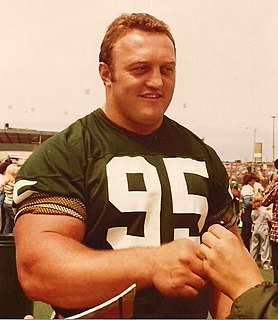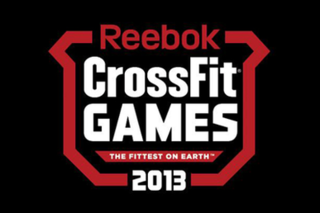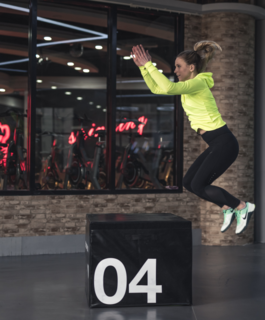
Weight training is a common type of strength training for developing the strength and size of skeletal muscles. It utilizes the force of gravity in the form of weighted bars, dumbbells or weight stacks in order to oppose the force generated by muscle through concentric or eccentric contraction. Weight training uses a variety of specialized equipment to target specific muscle groups and types of movement.

Powerlifting is a strength sport that consists of three attempts at maximal weight on three lifts: squat, bench press, and deadlift. As in the sport of Olympic weightlifting, it involves the athlete attempting a maximal weight single-lift effort of a barbell loaded with weight plates. Powerlifting evolved from a sport known as "odd lifts", which followed the same three-attempt format but used a wider variety of events, akin to strongman competition. Eventually odd lifts became standardized to the current three.

Calisthenics or callisthenics is a form of strength training consisting of a variety of movements that exercise large muscle groups, such as standing, grasping, pushing, etc. These exercises are often performed rhythmically and with minimal equipment, as bodyweight exercises. They are intended to increase strength, fitness, and flexibility, through movements such as pulling, pushing, bending, jumping, or swinging, using one's body weight for resistance. Calisthenics can provide the benefits of muscular and aerobic conditioning, in addition to improving psychomotor skills such as balance, agility, and coordination.

The bench press, or chest press, is an upper-body weight training exercise in which the trainee presses a weight upwards while lying on a weight training bench. The exercise uses the pectoralis major, the anterior deltoids, and the triceps, among other stabilizing muscles. A barbell is generally used to hold the weight, but a pair of dumbbells can also be used.

Strength training or resistance training involves the performance of physical exercises which are designed to improve strength and endurance. It is often associated with the use of weights. It can also incorporate a variety of training techniques such as calisthenics, isometrics, and plyometrics.

A squat is a strength exercise in which the trainee lowers their hips from a standing position and then stands back up. During the descent of a squat, the hip and knee joints flex while the ankle joint dorsiflexes; conversely the hip and knee joints extend and the ankle joint plantarflexes when standing up.
The snatch is the first of two lifts contested in the sport of weightlifting followed by the clean and jerk. The objective of the snatch is to lift the barbell from the ground to overhead in one continuous motion. There are four main styles of snatch used: squat snatch, split snatch, power snatch, and muscle snatch. The squat snatch and split snatch are the most common styles used in competition while power snatch and muscle snatch are mostly used for training purposes.

William Kazmaier is an American former world champion powerlifter, world champion strongman and professional wrestler. During the 1970s and 1980s, he set numerous powerlifting and strongman world records, and won two International Powerlifting Federation (IPF) World Championships and three World's Strongest Man titles. In the 1980s, Kazmaier became famous for his claim to be "the strongest man who ever lived" by equaling and surpassing spectacular and versatile feats of strength of famous strongmen of the 20th century. He is widely considered to be one of the all-time greatest competitors in strength competitions.
One-repetition maximum in weight training is the maximum amount of weight that a person can possibly lift for one repetition. It may also be considered as the maximum amount of force that can be generated in one maximal contraction. One repetition maximum can be used for determining an individual's maximum strength and is the method for determining the winner in events such as powerlifting and weightlifting competitions. One repetition maximum can also be used as an upper limit, in order to determine the desired "load" for an exercise.
Circuit training is a form of body conditioning that involves endurance training, resistance training, high-intensity aerobics, and exercises performed in a circuit, similar to high-intensity interval training. It targets strength building and muscular endurance. An exercise "circuit" is one completion of all set exercises in the program. When one circuit is completed, one begins the first exercise again for the next circuit. Traditionally, the time between exercises in circuit training is short and often with rapid movement to the next exercise.
The Wilks coefficient or Wilks formula is a mathematical coefficient that can be used to measure the relative strengths of powerlifters despite the different weight classes of the lifters. Robert Wilks, CEO of Powerlifting Australia, is the author of the formula.
Gary Deal was a weightlifter for the United States.
The Smolov Squat Routine is a weight training program for increasing your squat strength, originating from Russia. It is named after its creator, Sergey Smolov “the Russian Master of Sports”.
Janae Marie Kroczaleski is an American who previously competed as a professional powerlifter and competitive bodybuilder.
Edward Stephen Hall is a British former professional strongman. He won the World's Strongest Man 2017 competition. Hall has also won the UK's Strongest Man and England's Strongest Man competitions multiple times. Hall is also the official deadlift world record holder, pulling 500 kilograms (1,102 lb) under strongman rules in 2016.

Kettlebell Sport lifting is a repetitive weight lifting sport performed with kettlebells in a given period of time. Competitive kettlebell lifting has a long history in Russia and Eastern Europe, but developed as an organised, standard sport under the name kettlebell lifting during the 1960s.

The 2013 CrossFit Games, the seventh CrossFit Games, were held on July 24–28, 2013, at the StubHub Center in Carson, California. The men's competition was won by Rich Froning Jr., the women's by Samantha Briggs, and the Affiliate Cup by Hacks Pack UTE.

The 2016 CrossFit Games were the tenth CrossFit Games held on July 19–24, 2016 at the StubHub Center in Carson, California and on a ranch in Aromas, California, United States. The men's competition was won by Mathew Fraser, the women's by Katrín Tanja Davíðsdóttir, and the Affiliate Cup was awarded to CrossFit Mayhem Freedom.

Power training typically involves exercises which apply the maximum amount of force as fast as possible; on the basis that strength + speed = power. Jumping with weights or throwing weights are two examples of power training exercises. Regular weight training exercises such as the clean and jerk and power clean may also be considered as being power training exercises due to the explosive speed required to complete the lifts. Power training may also involve contrasting exercises such as heavy lifts and plyometrics, known as complex training, in an attempt to combine the maximal lifting exertions with dynamic movements. This combination of a high strength exercise with a high speed exercise may lead to an increased ability to apply power. Power training frequently specifically utilises two physiological processes which increase in conjunction with one another during exercise. These are deep breathing, which results in increased intra-abdominal pressure; and post-activation potentation, which is the enhanced activation of the nervous system and increased muscle fibre recruitment. Power training programmes may be shaped to increase the trainee's ability to apply power in general, to meet sports specific criteria, or both.

The 2017 CrossFit Games are the eleventh CrossFit Games and were held on August 3–6, 2017, at the Alliant Energy Center in Madison, Wisconsin, United States. This was the first Games held outside the state of California. The men's competition was won by Mathew Fraser, the women's by Tia-Clair Toomey, and Wasatch CrossFit won the Affiliate Cup. Fraser won $308,000 for his efforts and Toomey won $298,000 for her title, including bonus for event wins.